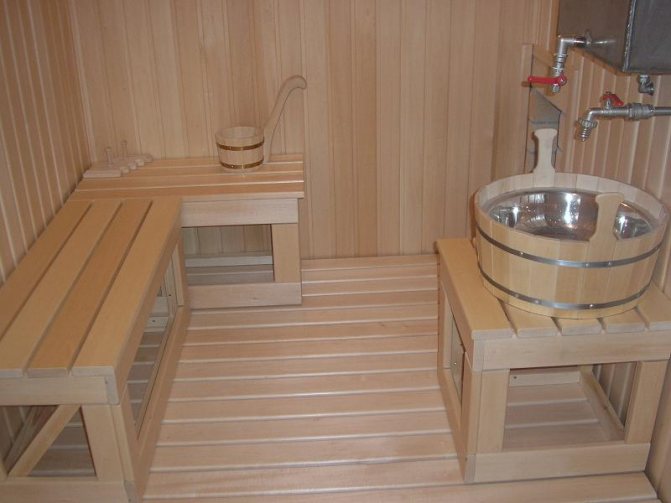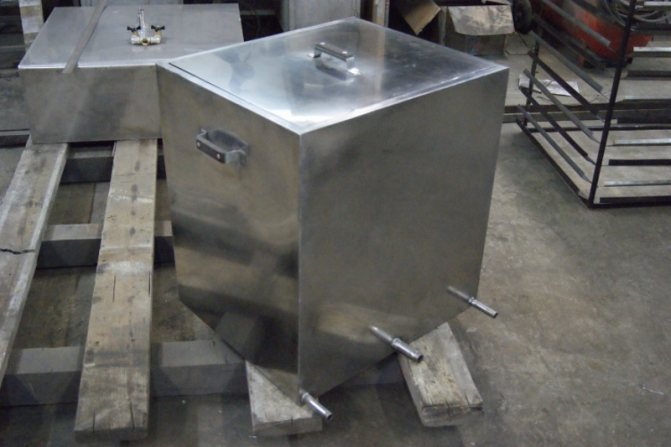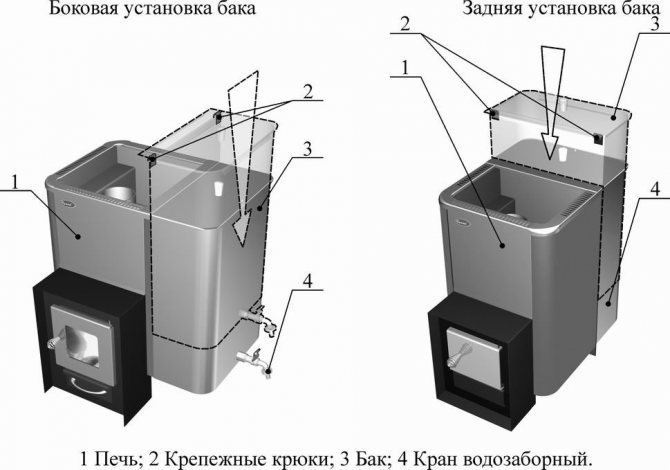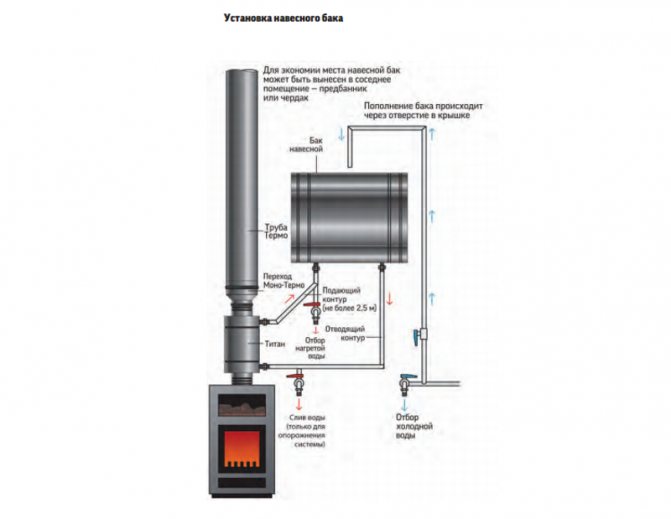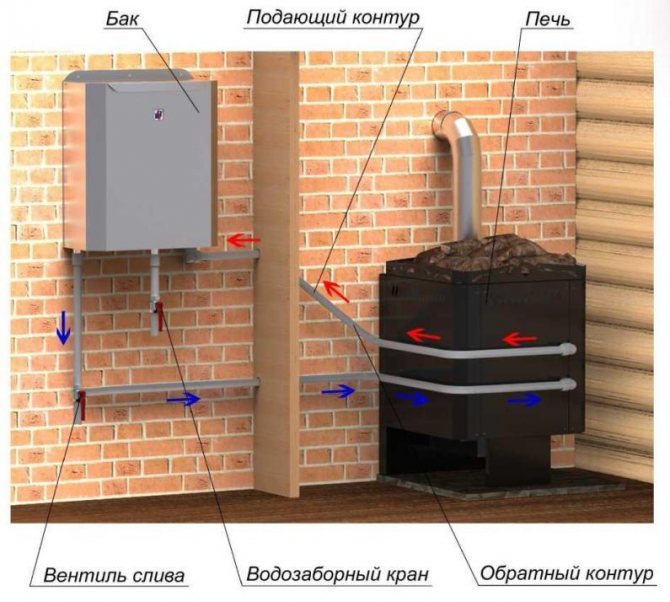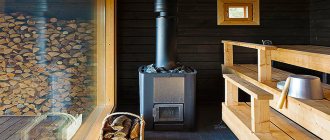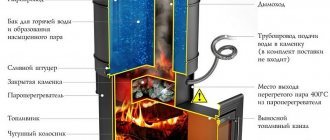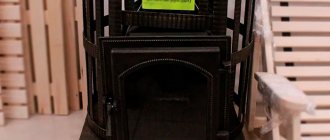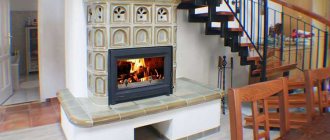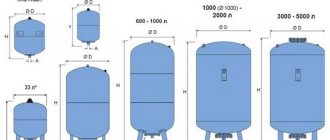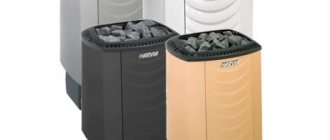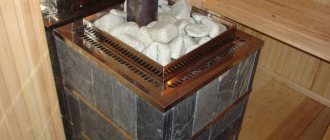Choosing a stove for a barrel bath
The choice of a stove for a bath is very important, because a stove is the main equipment of a barrel bath. Making a decision, we rely on the data:
- Steam room volume,
- Wall material (or quality of thermal insulation),
- The volume of additional adjacent compartments requiring heating,
- The required temperature and humidity in the steam room,
- Heating time
Pay particular attention to the power of the heater. If you install a stove with a low heating capacity in a steam room with a large volume, you will need to heat it up for a long time and more intensively, which will undoubtedly shorten the life of the stove.
It has been experimentally found that, according to the technical characteristics, the following stove models are best suited for barrel baths ranging in size from 2 to 6 meters: Rus 9, HARVIA M2, Termofor OSA and GRILL'D Aurora 160.
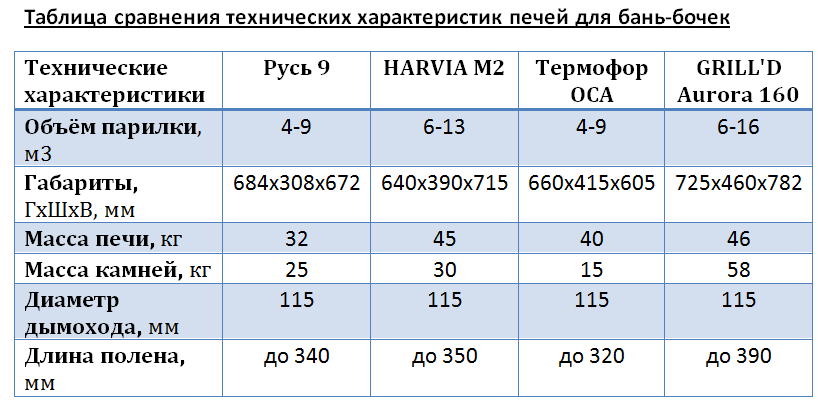
For a more complete and detailed acquaintance with the technical characteristics of each model, see the Operation Manual for the furnace you are interested in (you can download or watch it online):
- Rus 9 - manual_rus.pdf
- HARVIA M2 - harvia.pdf
- Thermofor OSA - manual_osa.pdf
- GRILL'D Aurora 160 - grill_aurora_160.pdf
Two variants of wood-burning stoves
Wood stoves come in two versions:
- With a firebox inside
- With the firebox outward.
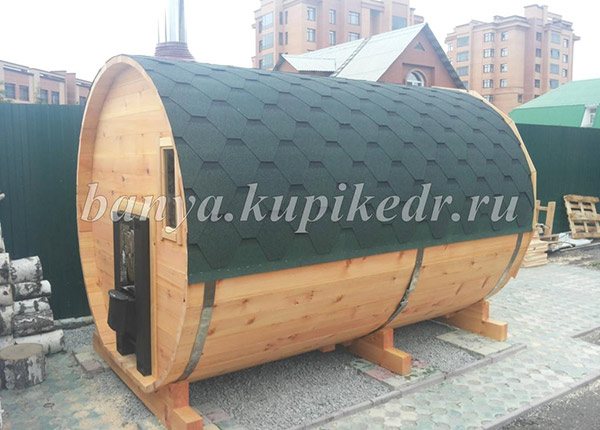

Which option to install is up to you. The only thing you should understand is that stoves with a firebox inside the bath will create additional difficulties associated with cleaning the ash pan from ash. This process takes care and patience. Additional work is required to install a stove with an external firebox in a barrel-bath. This leads to a slight increase in the total price of the bath (we have + 5000 rubles to the cost of the bath).
Features of the design of the stove-heater
General scheme of the furnace:
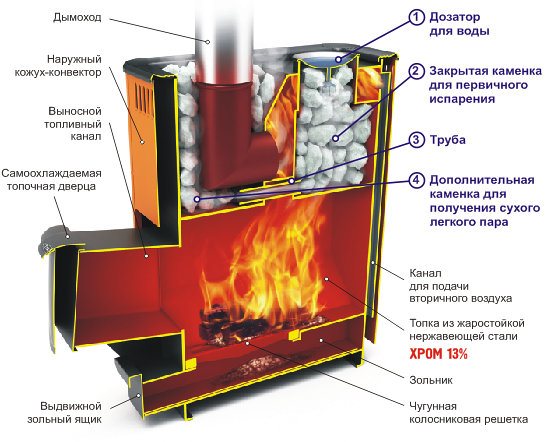

Such parts of the stove as the firebox and the stove bear the greatest thermal, corrosive and mechanical stress, therefore they are made of stainless high-alloy steel with a thickness of at least 2-4 mm. The chromium content in such steel is not less than 13-17%, which ensures a longer period of operation in oxygen-containing environments at high temperatures.
The furnaces are equipped with a multi-section steam generator and a mirror stainless steel convector. The convector covers most of the heat transfer surface of the oven. Due to the powerful circular convection flow created by it, the heating of air in the steam room and adjacent rooms is significantly accelerated. Hard infrared radiation emanating from the incandescent walls of the firebox is shielded by a casing-contour, which creates "soft" heat in the steam room.
The ventilated heater also acts as a powerful steam generator. An even temperature in the steam room is ensured by high-quality heated stones. One of the interesting details of the Harvia M2 model is that the standard door can be exchanged for a SCHOTT ROBAX® heat-resistant glass door. This will allow you to steam and admire the fire at the same time.
The stove is equipped with a drawer with an ash pan, thanks to which the intensity of combustion can be regulated. The grate, made of cast iron, ensures uniform, stable combustion along the entire length of the firebox.
The outer surfaces of the oven are covered with a double layer of organosilicon enamel. It is heat resistant and retains its properties at 600 ° C.


On the chimneys of all models of stoves, you can install a tank for heating water of the "samovar" type or install a universal register-heat exchanger for remote heating of water. They are made of stainless steel.
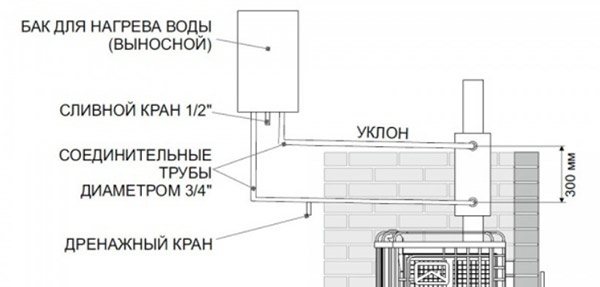

They are not included in the oven package and must be purchased separately.
Diagram of functional holes in the heater
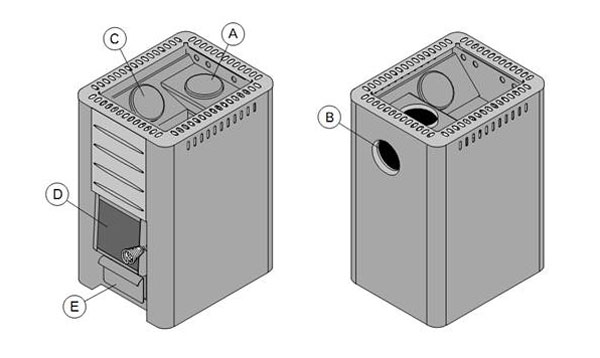

- A - Upper connecting hole
- B - Rear connecting hole
- C - Soot removal hole
- D - Firebox door
- E - Ash pan
Assembling a stove-heater with a breathing module
In the figure below, the points are laid out how to connect the chimney to the furnace:
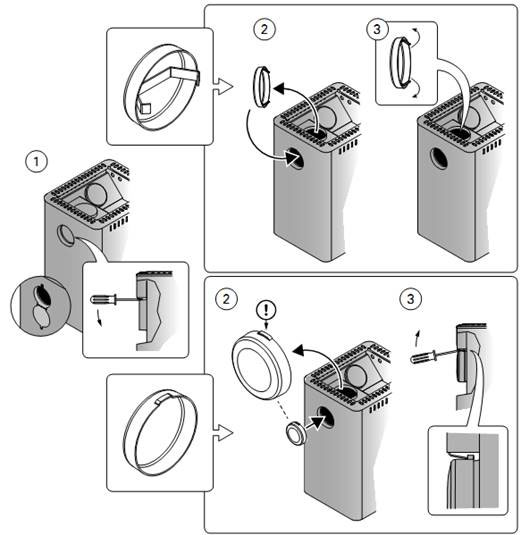

- Open the flap of the rear connection hole. Bend the holder with a screwdriver,
- Move the plug from the upper to the rear connection hole,
- Bend the holder with a screwdriver. Fold back the flap and secure it with the screw,
- Connect the flue pipe to the upper hole in the stove.
When using protective casing around the heater, the insulation of the chimney should start below the top edge of the casing or at the same level.
Step-by-step instructions for assembling a chimney with a photo:
- Install a tank on a pipe on the stove

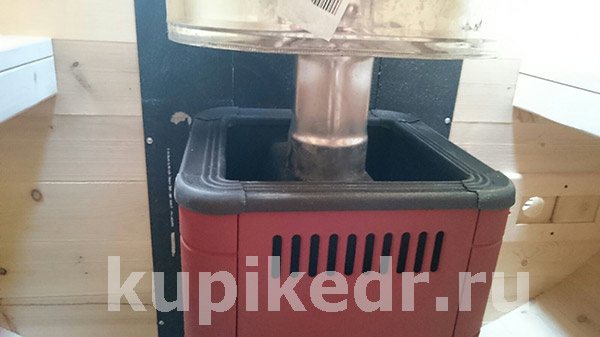
- Install the adapter after the tank on the pipe

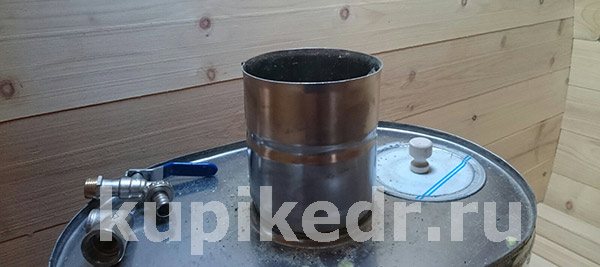
- After the adapter, a start-sandwich is installed


- Next is a sandwich pipe that goes through the roof, and a master flush and a head are put on top of it. A sandwich pipe has no insulation on one side from the inside along the edge - with this side it is placed on the start sandwich.

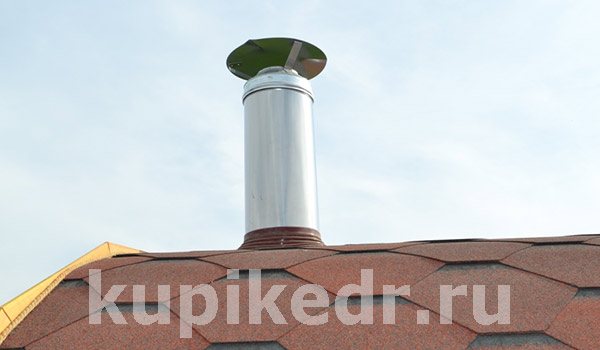
Types of sauna stoves by the location of water tanks
- remote tanks located separately from the oven
- built-in containers that are located in the body of the structure
- hanging tanks
- attached
- chimney
Remote tanks
This type of tank location is one of the best. It enables the stove to warm up the water and at the same time keep the adjacent room warm. And it also prevents the spread of moisture in the steam room while it is not yet really warmed up.
Most often, these tanks are made of stainless steel and placed in a nearby room. In order for the water to heat up from the stove, a register is installed that connects them through pipes or hoses.
To connect the water tank and the heat exchanger, it is better to use pipes that can withstand high temperatures. It is best to install stainless steel or copper pipes 50 cm from the stove. Reinforced-plastic pipes for hot water must be connected to them through fittings.
How to use
Pour water into the system while it is not hot. If it is poured in while the device is warmed up, the register can burst from sudden changes in temperature.
- the lower edge of the container should be located above the register by half a meter or more
- the total length of pipes or hoses must be no more than 3 meters
- the diameter of the pipes must be at least 2.5 cm
- sagging is excluded
- the slope should be 2-5 degrees
PROS:
- the ability to make a shower, a Finnish sauna, connect a battery for heating in winter changing rooms or showers
MINUSES:
- complexity of installation and connection
- rather big price for all the necessary parts of the system: heat exchanger, pipes, taps, installation costs from the masters
Built-in tanks
This is the basic type of tanks for sauna stoves, placed above the firebox or on one of its sides. The shapes of containers are different, but the most common is rectangular.
They are made of stainless steel, the wall thickness is in the range of 0.8-1.5 mm. Water is poured into them through a special hole, it is drained through ball valves. Nevertheless, such tanks are considered inconvenient, since they cannot be left empty, and constant boiling water creates excess, heavy and untimely humidity in the bath.
This forces you to frequently drain hot water and pour cold water. In addition, it is inconvenient to control the liquid level in the tank.
Hanging tanks
Hinged tanks are airtight containers with a lid and taps equipped for draining water. Such a tank is installed on one of the walls of the furnace.
They are usually made of stainless steel, since this metal is able to withstand strong loads for a long time.
There are also hinged tanks covered with enamel, but over time they become covered with chips and cracks, which reduce the efficiency of the tank.
Such tanks are attached with hooks or loops to the wall of the stove.This is very convenient, they are easy to assemble, provide the ability to attach them to an existing oven. Hanging tanks are well suited for small baths and stoves.
We suggest that you familiarize yourself with How to process aspen in a steam room
Their disadvantages are such factors as: the impossibility of making a shower, the need for an additional quiet enclosure to exclude the possibility of contact with the hot walls of the tank, as well as a problem, like with built-in tanks - the effect of excess and cold steam formed due to the fact that the water quickly boils at a time when the room has not yet completely warmed up. But in their case, you can adapt - hang the tank after warming up the steam room.
Many manufacturers offer such containers for a fee, but it is possible to order such a tank from a professional welder or make it yourself.
Side tanks
This is an original and not very common variant of the location of the tank. The pipe is welded at an angle from the oven to the bottom of the water tank. The tank is made higher than the oven.
- From the bottom, the liquid pours into an inclined pipe and boils in it.
- The resulting bubbles rise up the pipe and burst, ending up in cold water
- According to this principle, they transfer a lot of heat and form convection.
Chimney tanks
Chimney water tanks are one of the common types. Their other name is samovar-type tanks, because they are similar in principle to samovars. The bottom line is that hot air passes through a pipe located in the center of the body of any structure and heats the water.
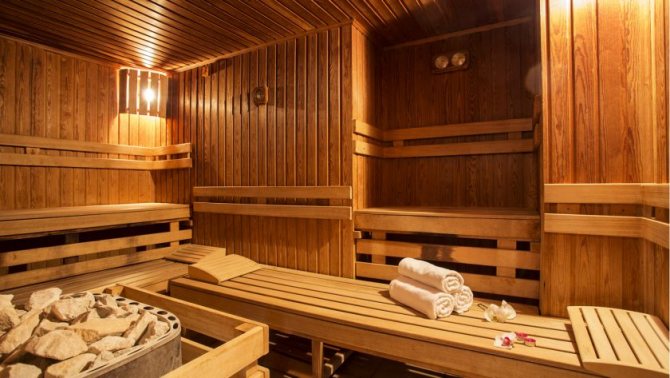

These containers have various shapes: triangular, round, oval, rectangular, square. This is one of the advantages - a variety of forms, there is a choice to your liking.
PROS:
- the heat is not wasted and heats the water
- long service life of the chimney
- there is no "cold steam" effect inherent in built-in and hinged tanks
- saving space in the steam room
MINUSES:
- It is inconvenient to fill the container with water - the filling hole is too high. This minus is smoothed out by the tanks located immediately above the stove.
- Difficult to control water level and temperature
- To have "dry steam", water must not be allowed to boil
- It is difficult to install a container on a chimney, because the weight with liquid reaches 100 kg or more. To do this, you need a good mount - the weight of the tank should not load the stove. But if the tanks come in a set from one manufacturer - there is no minus
There is a convenient and effective way to combine a small chimney tank with a take-out tank. A container with two pipes for hot and cold water is installed on the pipe. It is connected to a larger external tank - through this system, the liquid is circulated and heated.
- It is convenient to mount the tank on the chimney - after all, it has a small volume and weight, does not require special fastening, as with standard "samovar" tanks
- Since the remote tank can be installed anywhere, it is convenient to fill in water. If there is a water supply system, you can connect to it
- It becomes possible to control the water level
- Since the portable container can be located anywhere: in the dressing room, in the attic - there is no excess moisture in the steam room. There is control over the air condition
- It is possible to take a shower with some effort, but much easier than in the first option
Preparing the oven for operation
Before heating the stove for the first time, remove the protective films from the decorative panels on the stove body. Read the description and the operating instructions carefully.
When the oven is first heated, smoke and odor will be emitted from the combustion of industrial oil applied to the metal and volatile paint components. In the future, it will disappear and will not bother you.
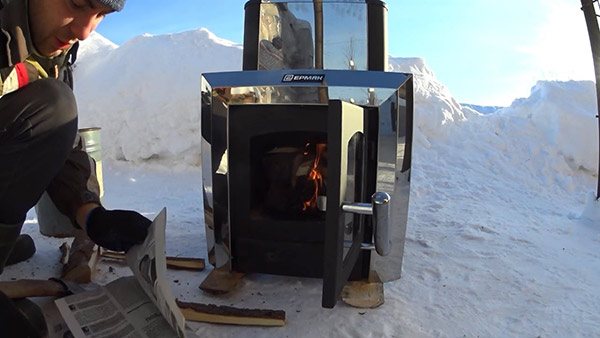

The first heating of the stove must be carried out with open doors and windows or not indoors. The time of the first heating is at least 1 hour.There must be a full load of the firebox, an empty heater and a tank filled with water
If you are doing your first heating outdoors, install a chimney on the stove to provide draft, which will ensure that odors are removed from it.
The heat-resistant paint on the outer casing of the stove dries completely and reaches its maximum strength when it is first heated. It is not recommended to wipe the painted surfaces of the stove before this. After the first heating, ventilate the room and drain the water from the tank.
If you pour water on the stove the first time you heat it, it can damage the paint and shorten the life of your stove.
During long-term operation of the furnace, deformation of the inner walls of the furnace may occur. In places of the greatest exposure to temperature - in the firebox, smoke collector and stove, burnout and peeling of the organosilicon coating can occur. This does not affect the life of the furnace in any way.
The principle of operation of wood-burning stoves
A wood-fired sauna stove with a water tank works as follows: firewood is placed in the firebox, which heats the body, and then the walls of the equipment produce heat transfer.


Principle of operation
At the same time, the room warms up quickly, but the heat does not last long and you have to constantly report firewood. Warmed air is lighter than cold air, and it rises upward from stones. Heated stones give off heat to the room.
Useful advice! Firewood should be set on fire from below. It is also required to periodically throw up firewood, since the fire is rapidly moving upward, and coals quickly remain.
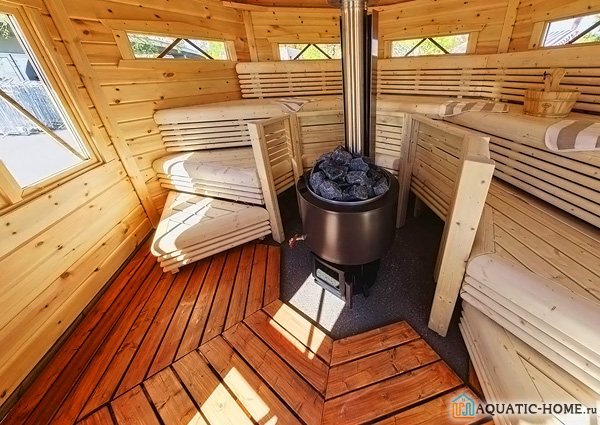

Equipment installation option
Related article:
Wood-burning stoves for summer cottages. Types of stoves, technical characteristics, models and prices, placement, and much more in a special publication of our portal.
What to use as a heating material
Dry wood is the best material for heating a heater. True, different types of wood have different heating values. So, beech firewood needs to be burned about 15% less than birch firewood to get the same amount of heat.
What should not be burned in the stove:
- Plastics, coal, briquettes, granules,
- Construction waste, wood with paint, sleepers,
- Rags, leather, rubber, diapers,
- Garden waste.
Some customers put a special gas-wood stove in the barrel bath. In this case, gas can be used as fuel.
Stove stones
It is advisable to buy heater stones in specialized stores. Stones of unknown origin, picked up in places of various types of industries and roads, may contain harmful chemical compounds. For example, on railway embankments, stones are treated with creosote. Using them will be hazardous to your health. You can use sea and river pebbles, it is better to take flattened stones, more will go into the heater, the packing will be denser and water will not get on the metal of the stove. You cannot take soft stones such as limestone. See the picture below for how to properly place stones in the heater.
To begin with, the stones should be rinsed in running water with a stiff brush. Large stones are placed on the bottom of the stove so that they adhere to the metal surface with the larger side. This increases the contact area. Small stones are packed tightly between large stones.
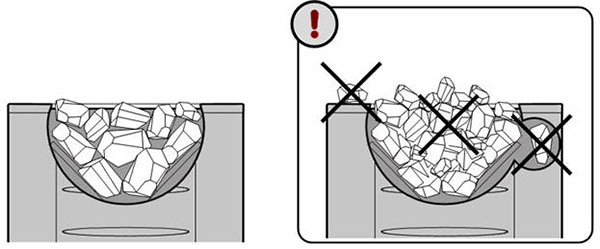

It is not necessary to stack stones above the upper level of the heater. They will not warm up to the temperature required for high-quality vaporization.
It is recommended to use a safety net for the heater basket. It protects the stove from overfilling, and can also be used to steam the broom and protect stones from falling leaves on them.
Correct placement of stones in the heater:
- The diameter of the stones should not be more than 15 cm,
- The best types of stones are: olivine, olivine-dolerite and peridotite. The popular gabbro-diabase is cheaper, but not the best option.It gains heat for a long time and cools down quickly. In addition, it can break down and clog the grates of the furnace, i.e. it must be sorted out regularly, throwing out crumbling stones,
- When laying, make sure that air circulates between the stones,
- Do not pile stones on or on top of the grate around the stone placement.
- Do not place stones between the grate and the stove body.
Materials for arranging chimneys
Chimneys must meet the following parameters:
- Resistant to soot, which can cause deterioration of finishing materials.
- Compliance with fire safety requirements.
In this regard, modern buildings can be equipped with only those structures that fully comply with the requirements presented.
- Brick chimneys. Brick is a refractory material with good heat dissipation, which helps to quickly heat up the room and maintain the temperature. But this material requires special skills for installation and needs regular cleaning. These characteristics make it impossible to install a tank for heating water on a pipe. In this case, it is recommended to use a detail model.
- Ceramic building elements are able to withstand strong heating, have a long service life, but are quite expensive.
- Asbestos cannot be used when arranging a chimney, as it does not tolerate a sharp change in temperature.
- Ferrous metal is not suitable for operation in the required conditions, as it burns out quickly and weighs a lot.
- Stainless steel products are more resistant to temperature changes and have a more affordable price. Stainless steel chimneys are the most demanded option. Due to their low thermal conductivity, metal products quickly heat up and do not retain heat. This property is used to quickly heat water with minimal fuel consumption.
A tank for heating water on a tube has been installed since ancient times, it is enough to recall the legendary Russian samovar, a kind of symbol of our people. This principle was first used in it, for this reason such systems are also called samovar systems.
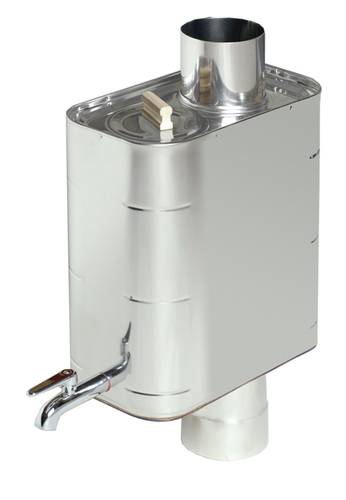

Tank with side valve.
- When a stove is heated in a bath, the pipe in it will heat up in any case, it is stupid not to use this energy and it can be safely considered completely free.
- Depending on the type of fuel, the temperature of this part of the structure ranges from 300 to 700 ºС. Moreover, a significant advantage is that the pipe heats up evenly over the entire contact area.
- The volume of such a tank can be quite large, because the distance from the furnace to the ceiling will be at least one and a half meters, and such a heater can be equipped along the entire length of the pipe.
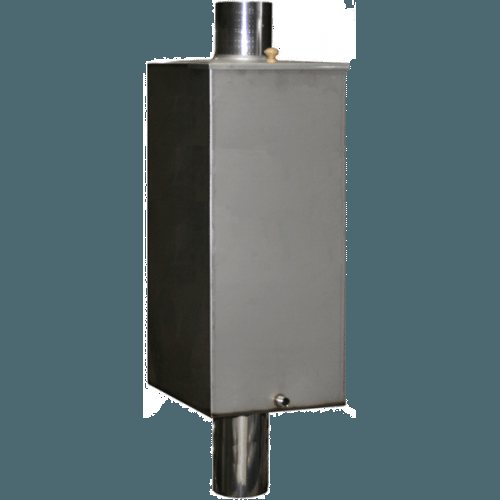

Square heater.
- Such a heater, in most cases, does not need an additional pump, heat exchanger or electric heating element.
- A normal stove for a small steam room has an average pipe section of about 115 mm. Taking into account the thickness of the container, the transverse dimensions of the entire structure will be within half a meter. That allows you to place it in any, even a small steam room.
- Installation does not require fundamental knowledge of heating technology or being a super locksmith. Almost any owner will be able to install such a container on a pipe with his own hands.
- And finally, when compared with a boiler, the price of such a miracle will be quite affordable, and the investment will be one-time.
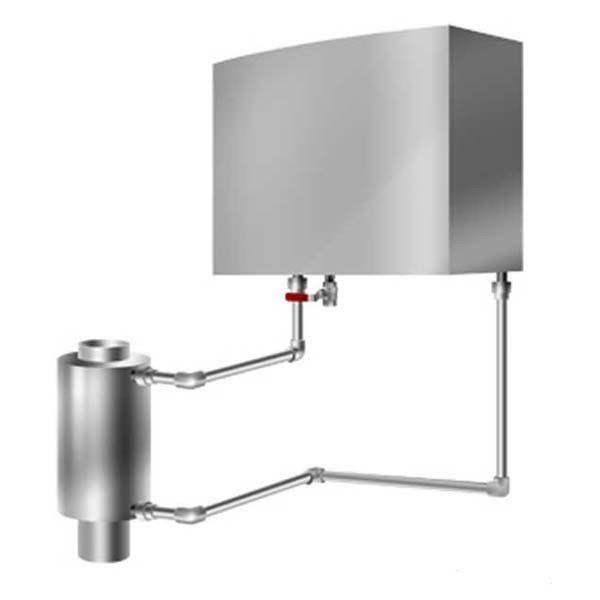

Diagram of a heat exchanger on a pipe.
- The most significant disadvantage is that the water heating tank on the pipe can be installed exclusively on metal structures. Ceramics or pipe bricks do not have this level of heat transfer.
- Constructions in which water is poured through the top, directly into the steam room, will increase the humidity level in the room.
- Hot metal tank walls are a source of danger, careless touching can result in injury.
Tank with a hatch.
Traditionally, it is customary to assume that one person needs at least 10 liters of water for bathing procedures. To this should be added another 10 - 20 liters for steaming brooms and related procedures. Hence, the minimum capacity of the tank for a rest for two should be in the region of 50 liters, and such a tank will fit on a small stove without any problems.
But if you expect to take a steam bath with a larger company, then it makes sense to mount a large container, until the very overlap. But this option has a significant disadvantage, such a structure, in a filled state, will be quite heavy and a reinforced foundation will be required for such a furnace.
We invite you to familiarize yourself with the device of a chimney from sandwich pipes through the roof
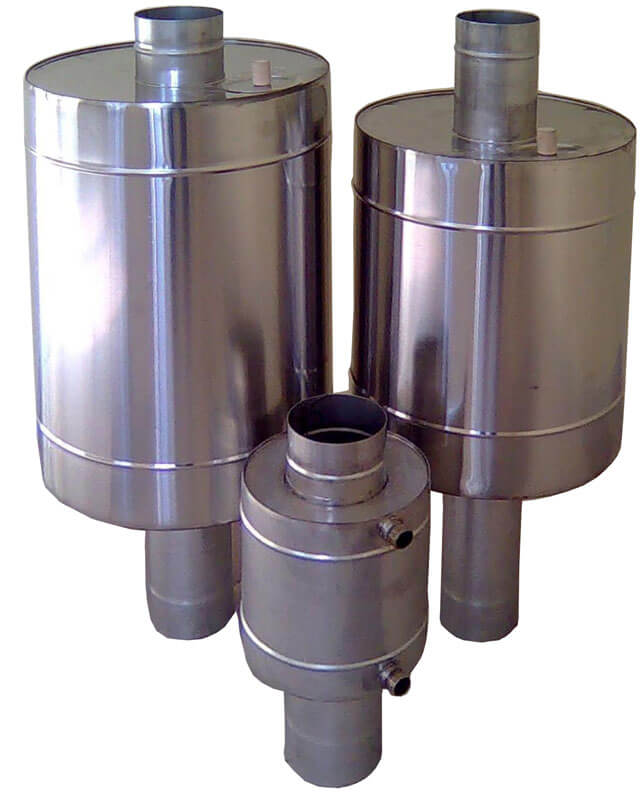

The most acceptable is the option in which the tank for heating water to the pipe works exclusively as a heat exchanger. Here you do not need a large and heavy container, 20 - 30 liters is quite enough. Any furnace can withstand such a weight, plus structures of this type are made sealed. Of these, 2 outputs are mounted leading to a remote tank, which can be arbitrarily large.
Chimney heat exchanger.
There is a variant of using the inner surface of the tank directly as a pipe, the heating rate in this case increases significantly. But experts advise to select a tank in such a way that the container fits tightly on the pipe. This option is beneficial in that it does not require a large wall thickness and in case of a chimney burnout, it will be easier to replace it.
In the old days, cast iron was the most popular material. Of course, it will heat up a little longer, but on the other hand, the temperature will hold up better. An important factor is the resistance of cast iron to corrosion and a long service life. But cast iron is a heavy material and a powerful support is needed for such a container.


Cast iron stove with a tank.
Ferrous metal for these purposes is now practically not used due to the tendency to corrosion and the high probability of deformation during sudden temperature changes.
Stainless steel is deservedly considered a versatile material. This metal is not afraid of corrosion and has a relatively low weight. In order to weld a large-capacity tank, a sheet with a thickness of 1.5 - 2 mm is enough. During temperature changes, such containers are not deformed.
The video in this article shows the opinion of a specialist.


Assortment of tanks.
Heating up the heater
It is better to melt the stove with wood chips and finely chopped dry wood. The furnace should be filled up to 2/3 of the volume. Do not put firewood in the remote fuel channel. It is also prohibited to use various types of waste with flammable components as fuel.
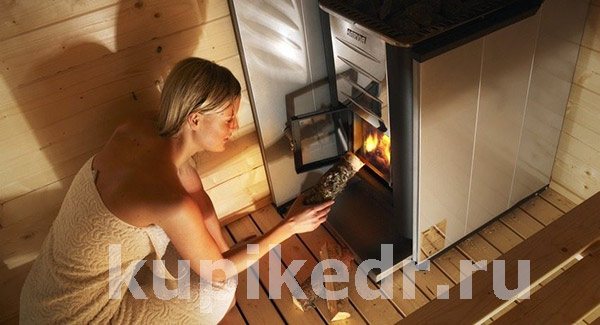

When the draft becomes stable and half of the loaded firewood burns out, you need to add firewood to 2/3 of the full load of the furnace and open the ash pan.
After the optimum temperature is established in the steam room, you need to cover the ash pan and maintain a stable temperature regime with coarsely chopped wood. The optimal number of logs is 3-4 pieces.
When loading the next batch of firewood, you need to completely close the ash pan and only after loading smoothly open the door
5 steps to correct kindling:
- Clean the ash pan,
- Put firewood in the firebox. Air must pass freely between the logs in the firebox. Small firewood is placed on large firewood. Choose logs no larger than 12 cm,
- Put the wood chips on top of the wood for ignition. This kind of firewood firing reduces the amount of emissions,
- Set fire to the wood chips, close the door. By opening the ash pan, you regulate the draft in the firebox. Never heat the oven with the door open,
- Add more firewood to the firebox as the embers begin to fade.
Long and strong heating entails a risk of fire!
Remember:
- Several full loads in a row can create excessive heat and overheat the stove and chimney.This will shorten the life of the equipment and may also cause a fire.
- Based on experience, it can be argued that temperatures over 100 ° C are too high for a sauna,
- Use as much wood as indicated in the heating instructions. Be sure to cool down the stove, chimney and sauna room.
Wood-fired sauna stoves with a water tank: device features
The main purpose of wood-fired sauna stoves with a water tank is to warm up the room for a certain period of time.


Heating design options
For high-quality heat transfer, the structure is equipped with the following elements:
- The main element of the heater is the heater. Stones are placed in it, which are heated by the heat of burning wood and create a stable heat flow.
- The chimney is a pipe that is connected to the firebox and is designed to remove combustion products.
- The heat exchanger is designed to heat water during the heating of the structure.
- The firebox consists of a grate.
- The ash pan is located under the grate. Ash gets there.


Design features
Such units are often made of brick or metal. Cast iron is used to create a grate. This material is durable and can withstand very high temperatures.


Cutaway furnace installation project
Stove water
The water you apply to the stones must be clean tap water. If it contains a high content of salt, iron, lime or humus, this can lead to rapid corrosion of the stove.
The use of seawater guarantees the fastest corrosion of the stove
Requirements for the quality of tap water:
- Humus content less than 12 mg / liter,
- Iron content no more than 0.2 mg / liter,
- Calcium content below 100 mg / liter,
- Manganese content up to 0.05 mg / liter.
Water is poured only on stones, since if you splash water on highly heated metal surfaces, then the paint can swell from a large temperature difference.
Choosing a water tank
When choosing the volume of the hot water tank, you can use the rule: 10 liters per person and 10 liters for steaming a broom.
It is estimated that the optimal volume of the hot water tank in the barrel bath is 50-55 liters. This is enough for all family members or a small group of friends to wash.
The water in the chimney tank heats up to 70-75 ° C by the time the air in the steam room heats up to 90 ° C. For ovens equipped with a steam generator, we recommend installing a stainless steel tank with two fittings. The tank is installed on the furnace so that the fittings are located above the funnels of the steam generator.
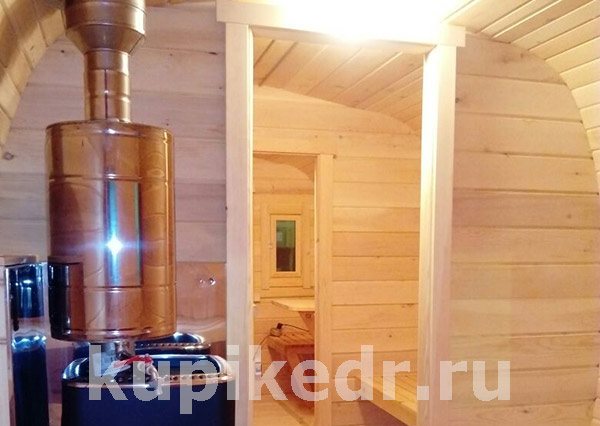

Stove maintenance
The service life of the oven and barrel-bath depends on a serious attitude to the implementation of the rules for operating the stove and barrel-bath. Take simple steps and regularly monitor the condition of the equipment so that it will serve you for a long time.
Kamenka
- Clean the ash pan. The air passing through it should cool the grate well. This increases its service life. Collect the ashes in a metal container,
- The soot and ash that accumulate over time in the smoke ducts of the stove must be removed through the round holes on the sides of the stone space.
- The stones must be repositioned at least once a year, since they are destroyed due to high temperatures during prolonged use. Remains of stones are removed, destroyed ones are replaced with new ones. It is recommended to check gabbro-diabase stones more often, about once every six months,
- Remove dust and dirt from the heater with a damp cloth.
Chimney
- The chimney and connecting pipes must be cleaned periodically, because Due to incomplete combustion of the fuel, soot accumulated in the chimney can ignite.
What to do in the event of a chimney fire
If the operating conditions of the oven are met, such a situation will not arise, but you should know what to do in this case. It's just like you have to be able to do artificial respiration in the hope that this skill will not be useful to you.
- Close the ash pan, the firebox door and the latch, if installed,
- Call the fire department
- Do not put out fire with water



